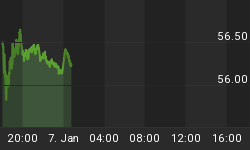Last week, when the U.S. Treasury unveiled the basics of their lender "stress tests", the Fed concluded that "most U.S. banking organizations currently have capital levels well in excess of the amounts required to be well capitalized." Simultaneously, they also claimed that the banks needed more capital. Apparently the Fed has little understanding of irony.
Why would our central bankers conclude that "well capitalized" banks need "more capital?" Quite possibly, they believe, as I do, that the rosy economic assumptions that form the basis of the "stress tests" may be far too optimistic. I believe that neither the Fed nor the Treasury have any will to paint a clear picture of our financial turmoil. But that won't stop them from operating under those assumptions.
A brief examination of the stress test assumptions shows why the Fed should be hedging their bets.
First, the level of stress in the tests was set unrealistically low. Their absolute worst case assumption was for a GDP contraction of only 3.3 percent in 2009. This comes as first quarter 2009 GDP shrank at 6.1 percent. And the economy is still slowing. To post a contraction of just 3.3 percent for the year would likely involve an immediate reversal in the rate of contraction and outright expansion by the fourth quarter.
The stress test also assumes a worst case scenario unemployment rate of 8.9 percent in 2009. This is also wildly optimistic when unemployment is already at 8.7 percent and rising at some 20,000 each day. Worse still, if calculated on a pre-Clinton basis, to include all those unable to find anything but part-time employment, the current unemployment rate is a staggering 19.2 percent, or just 0.8 percent from official depression levels! It appears that the U.S. is fast slipping from recession into depression, rendering the stress tests almost meaningless other than as a public morale boosting exercise.
Second, the conclusion that "most" of the banks are well capitalized, as the Fed claims, also strains the bonds of credibility. The nineteen banks tested have total assets of $11.5 trillion. Technically, sixteen of these banks already are insolvent. If any two fail, they will exhaust the current FDIC bank deposit insurance fund. Only three of the banks, accounting for just 6 percent of the group's assets, could survive even the most liberal worst case scenario assumed by the Treasury. Meanwhile, the five largest and most vulnerable banks, with about $8 trillion in assets, account for some 70 percent of the group's total assets.
Some observers point to the relative security of the smaller regional banks, which did not engage as heavily in leveraged investments. However, the FDIC list of troubled banks has risen in the past three months from 1,568 banks with about $2.3 trillion in assets to 1,816 banks with some $4.4 trillion in assets. The risk has almost doubled, seemingly overnight!
Finally, by suspending the needed discipline of mark-to-market accounting, the profits of many banks have been massaged deceptively upwards. For example, a 'real' loss of more than $2 billion at Citibank was 'fudged' into a published profit of $1.6 billion.
The observers at the Fed and Treasury, as well as the most sophisticated investors around the world, are neither ignorant nor ill-informed. Despite their stress tests, they must be aware of the possibility of massive bank failures and terrifying aftershocks. This belief may have been a factor in a rumor, circulated after the stress tests were announced, that defensive maneuvers to avoid a run on the dollar, including the elimination of hedged short sales against the dollar, would soon be announced. If such a rule were to be put forward it would rightly be seen as a precursor to internationally coordinated foreign exchange controls, that would abruptly bring an end to the benefits of free trade.
Meanwhile, China has used its huge domestic gold production to double its gold reserves. Such clear concern over the viability of paper currency may encourage other central banks and even corporations to follow suit, making physical gold even harder to obtain. Gold therefore, is likely to experience renewed buying pressure as panic buying overcomes the downward 'commodity' selling pressure of depression.
For a more in-depth analysis of our financial problems and the inherent dangers they pose for the U.S. economy and U.S. dollar, read Peter Schiff's newest book "The Little Book of Bull Moves in Bear Markets." Click here to order your copy now.
For a look back at how Peter predicted our current problems read the 2007 bestseller "Crash Proof: How to Profit from the Coming Economic Collapse." Click here to order a copy today.
More importantly, don't wait for reality to set in. Protect your wealth and preserve your purchasing power before it's too late. Discover the best way to buy gold at www.goldyoucanfold.com. Download Euro Pacific's free Special Report, "Peter Schiff's Five Favorite Investment Choices for the Next Five Years", at http://www.europac.net/report/index_fivefavorites.asp. Subscribe to our free, on-line investment newsletter, "The Global Investor" at http://www.europac.net/newsletter/newsletter.asp. And now watch the latest episode of Peter's new video blog, "The Schiff Report", at http://www.europac.net/videoblog.asp.















